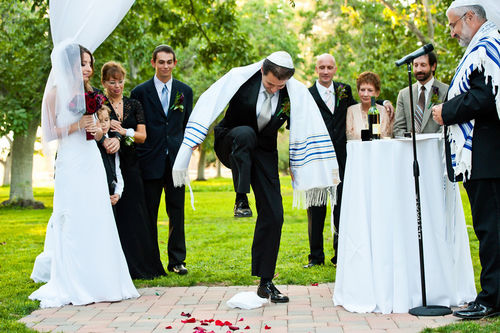The wedding ring in Judaism

In Judaism, the wedding ring plays an important role in the Jewish wedding ceremony, but after the wedding is over, many men do not wear a wedding ring and for some Jewish women, the ring ends up on the right hand.
origins
The origin of the ring as a wedding custom in Judaism is somewhat flaky. There is no specific mention of the ring used in wedding ceremonies in any ancient work. In Sefer ha'Ittur, a collection of Jewish judgments of 1608 on the monetary issues, marriage, divorce and (marriage contracts) of Rabbi Yitzchak Bar Abba Mari of Marseille, the rabbi recalls a curious custom from which the ring as a necessity of the marriage may have arisen. According to the rabbi, the groom would have performed the wedding ceremony in front of a cup of wine with a ring inside, saying: "Here you are engaged to this cup and all that is inside it". However, this was not recorded in later medieval works, so it is an unlikely point of origin.
Rather, the ring probably originates from the basics of Jewish law. According to Mishnah Kedushin 1: 1, a woman is acquired (i.e. girlfriend) in three ways:
Through the money
Through a contract
Through sexual intercourse
Theoretically, sexual intercourse is given after the wedding ceremony and the contract comes in the form of a ketubah which is signed at the wedding. The idea of "acquiring" a woman with money sounds strange to us in the modern period, but the reality of the situation is that the man is not buying his wife, he is providing her with something of monetary value and she is accepting it by accepting the article with a monetary value. In fact, since a woman cannot be married without her consent, her acceptance of the ring is also a form of the woman who agrees to marriage (just as she would do with a sexual relationship).
The truth is that the object can be absolutely of the lowest possible value, and historically it had been anything from a prayer book to a piece of fruit, a deed of ownership or a special wedding coin. Although the dates vary - anywhere between the XNUMXth and XNUMXth centuries - the ring became the normative element of the monetary value given to the bride.
Requirements
The ring must belong to the groom and must be made of a simple metal without precious stones. The reason for this is that, if the value of the ring is misunderstood, it could theoretically invalidate the marriage.
In the past, the two aspects of the Jewish wedding ceremony often did not take place on the same day. The two parts of the wedding are:
Kedushin, which refers to a sacred action but is often translated as an engagement, in which the ring (or sexual intercourse or contract) is presented to the woman
Nisuin, from a word meaning "elevation", in which the couple formally begin their marriage together
Nowadays, both sides of the wedding take place in rapid succession in a ceremony that usually lasts about half an hour. There is a lot of choreography involved in the complete ceremony.
The ring plays a role in the first part, kedushin, under the chuppah, or wedding canopy, in which the ring is positioned on the index finger of the right hand and the following is said: "Be sanctified (mekudeshet) with this ring in in accordance with the law of Moses and Israel. "
Which hand?
During the wedding ceremony, the ring is placed on the woman's right hand on the index finger. An obvious reason for using the right hand is that oaths - both in the Jewish and Roman traditions - were traditionally (and biblically) performed with the right hand.
The reasons for positioning on the index vary and include:
The index finger is the most active, so it is easy to show the ring to viewers
The index finger is actually the finger on which many wore the wedding ring
The index, being the most active, would not be the likely place for the ring, so its position on this finger shows that it is not just another gift but that it represents a binding act
After the wedding ceremony, many women will place the ring on the left hand, as is custom in the modern western world, but there are also many who will wear the wedding ring (and the engagement ring) on the right hand on the finger ring. Men, in most traditional Jewish communities, do not wear a wedding ring. However, in the United States and other countries where Jews are in the minority, men tend to adopt the local custom of wearing a wedding ring and wearing it on the left hand.
Note: to facilitate the composition of this article, the "traditional" roles of "spouses" and "husband and wife" have been used. There are different opinions in all Jewish confessions about gay marriage. While the reformed rabbis will proudly officiate gay and lesbian marriages and conservative congregations that vary in opinion. Within Orthodox Judaism, it must be said that although gay marriage is not approved or performed, gay and lesbian people are welcome and accepted. The phrase often quoted reads "God hates sin, but loves the sinner".